By Al Paulson
The Mighty Mite Gemtech’s Tiny LDES-2 Suppresor
The new LDES-2, .22 caliber sound suppressor from Gemtech represents a major redesign and a significant downsizing of the LDES suppressor. The most visible feature of the new can is its diminutive diameter, only 7/8 inch (22 mm), which enables full use of the sights on a Walther TPH pistol. The smaller envelope also helps the professional operator conceal the suppressor more readily when that is a requirement. The LDES-2 is certainly the smallest successful suppressor that I’ve ever seen. The most revolutionary feature of the new can remains hidden inside the suppressor: a new baffle developed jointly by James Ryan and Dr. Philip Dater soon after they joined forces to form Gemtech.
Ryan and Dater actually incorporated two new baffle designs into the baffle stack of the full-sized Vortex-2 .22 rimfire suppressor. The much smaller LDES uses the rearmost two baffles from the Vortex-2. The still smaller LDES-2 uses a trimmed-down variant of the same two baffles. The key to the performance of these baffles is a series of complex asymmetric shapes that maximize turbulence. But these innovative baffles do not provide enough performance alone when just two baffles are used in a very small suppressor. A coolant medium must also be employed in the LDES and LDES-2. This medium evaporates with each shot and thus cools the gases, robbing them of energy that would be perceived as sound. The coolant medium can be a liquid such as water or Break Free, or a more viscous material such as grease or petroleum jelly. Suppressors that use a coolant medium are commonly referred to as wet cans, while suppressors that do not use a liquid or grease coolant are called dry cans. Thus the Vortex-2 is a dry can. The LDES and LDES-2 are wet cans.
Both types of the new baffles used in the Vortex-2 are quite versatile, and are also incorporated into Gemtech’s Quantum and Operator suppressed Ruger pistols, as well as Gemtech’s Quantum suppressed Ruger rifles. Basic elements of the new baffle designs developed for these .22 rimfire suppressors have also been adapted to a small, high-performance suppressor called the Raptor, which snaps onto the three-lug barrel of an MP5 submachine gun using a patented Tri-Lock quick-couple mount. Designed by Gregory Latka for Gemtech. (The Tri-Lock is the best mounting system ever developed for the MP5 in my opinion.)
Gemtech’s experience with these new baffles enabled their design team to develop a remarkably innovative snap-on suppressor called the Model M4-96D for the Colt M4A1 carbine in just five weeks. The M4-96D snaps onto a propriety Bi-Lock flash hider, permits the full use of all accessories (including blank-firing device, bayonet and grenade launcher), and was one of two contenders (the other is the Model QD from Knight’s Armament whose design was recently awarded the contract) for a new military contract that could run as high as $6 million to meet the requirements set forth by NAVSURFWARCENDIV for sound suppressors, which would technically be a component of the SOPMODM-4A1 accessory kit. The patented Bi-Lock snap-on mounting system, also developed by Greg Latka, is quite different 50 percent of the time, depending on the kind of ammunition being used. I’ve therefore relegated my TPH to service as a photographic model, and will henceforth use a Beretta Model 21A as my test gun. This evaluation will still use the TPH one last time to determine if the suppressed and unsuppressed sound signatures of the two pistols differ.
Both Gemtech and AWC Systems Technology adapt Beretta pistols for suppressors by drilling out the original barrel and inserting a turned-down, threaded barrel blank, which is silver soldered in place and then chambered. I had this conversion performed on a Beretta Model 21A chambered for .22 LR and a Beretta 950 BS Minx chambered in .22 Short. The latter makes a dramatically tiny package when fitted with an LDES-2 suppressor.
Remarkably, the pistol from the Auto Nine Corporation (currently made by Wilkinson Arms of Parma, Idaho, and called the “Sherry”) is virtually as short and thin as the Minx. But the Sherry fires the .22 Long Rifle cartridge, and it does so with profoundly better reliability than the Walther TPH. The original variant of the Sherry used in this study will henceforth be referred to as the Auto Nine. This pistol was designed by Roy Wilkinson, who also designed the excellent AMT Backup pistol. The common heritage of these two guns is readily apparent. Unfortunately, the sights on the Auto Nine are too fine for rapid target acquisition, and the trigger is quite creepy. I would have preferred the simple sighting channel of the AMT Backup to the traditional front and back sights of the Auto Nine, since the .380 Backup provides rapid target acquisition while delivering consistent head shots on a Pepper Popper at 7 yards (6.4 m). Nevertheless, the .22 caliber Auto Nine or its current incarnation—the Sherry—performs well enough to be a serious contender for a pocket pistol’s typical operational envelope of an armspan or two.
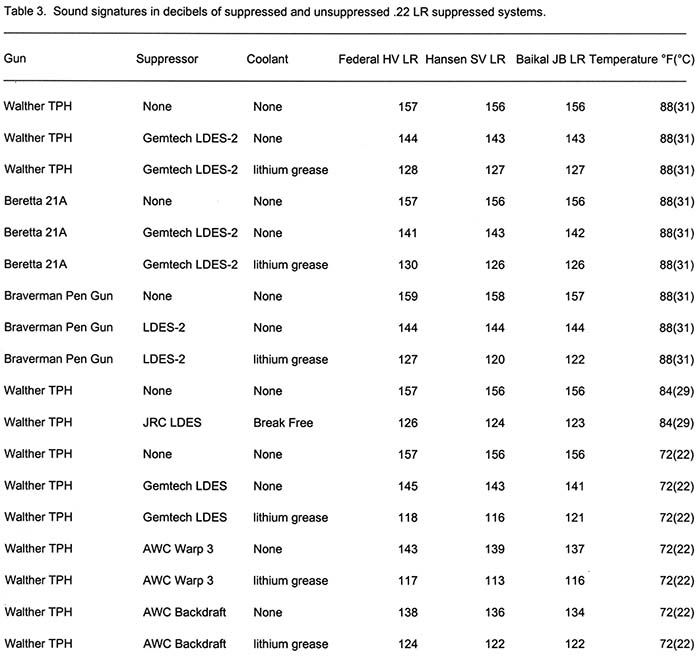
That said, if the substantial bulk of the Beretta Model 21A is not a liability, this Beretta remains the best .22 LR pocket pistol in the U.S. marketplace for mounting a suppressor in my opinion. It is interesting that Mossad (Israeli version of the CIA) operatives use .22 caliber Berettas in preference to Walthers and other pistols in the international marketplace.
The Braverman Pen Gun used in this study was threaded and fitted with a thread protector by Gemtech.
Using Coolant Media in Wet Cans
Using a coolant medium to create an artificial environment (a term coined by Lynn McWilliams) provides several advantages over using dry cans. Wet cans eliminate the first-round pop common to most suppressors. Wet cans are much smaller and lighter than dry cans. And wet technology permits the design of a suppressor that can deliver substantially better sound reduction than a dry design.
Artificial environment technology also has several disadvantages. Wet cans liberate a small cloud of mist every time a shot is fired. This could disclose the operator’s position, although this is not much of a concern when wet technology is married to a .22 caliber pocket pistol or pen gun. Nevertheless, the operator’s face, arms and torso are sprayed with sooty droplets of coolant. Thus, eye protection is advisable. Another liability of wet technology is that the suppressor must be recharged with coolant every three to 30 rounds, depending on such factors as the design of the suppressor, barrel length, muzzle velocity of the ammunition being used, and whether the ammunition features a solid or hollow point.
A final consideration for concealed carry is that liquid coolants tend to leak out of the suppressor. While a particular wet can (such as the Backdraft from AWC Systems Technology) may provide superior performance using a liquid coolant rather than a grease or gel, all wet cans tested to date provide plenty of sound suppression when using a lithium grease, which has become my coolant medium of choice for virtually every concealable wet can in the marketplace. The only exception is Gemtech’s tiny new Aurora suppressor designed for the Glock 26; a grease with the lowest possible latent heat of evaporation works best for this ultra-tiny 9mm suppressor, which is about the same size as Gemtech’s LDES .22 caliber suppressor.
With the exception of Gemtech’s Aurora, I’ve found that Mobil Premium Lubrication Grease works particularly well as a coolant medium for a suppressed carry gun, since its lithium content gives it a particularly high latent heat of evaporation. Some operators use Shooter’s Choice All Weather High-Tech Grease since it is packaged in a plastic syringe that makes recharging tiny .22 suppressors very convenient. Mobil Premium Lubrication Grease was used as the coolant medium for all tests reported in this study with the exception of the JRC LDES testing, which was conducted several years ago using Break Free as the coolant.
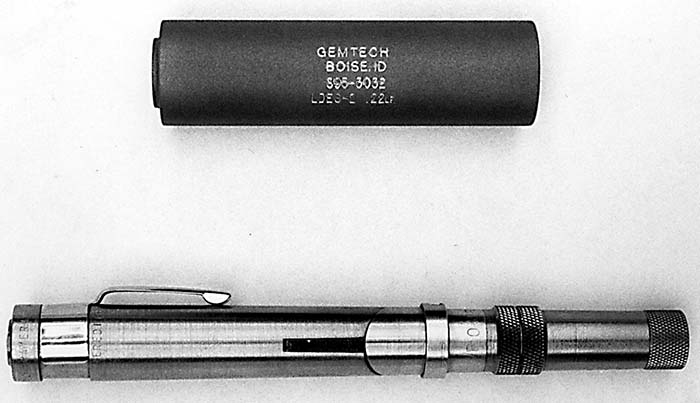
Testing Procedures
Sound signatures were measured using a Brüel and Kjaer Type 2209 Impulse Precision Sound Pressure Meter (set on A weighting and peak hold) with a B&K Type 4136 1/4-inch condenser microphone, placed exactly 1 meter away from the front of the suppressor or muzzle according to U.S. Army testing procedures specified in MIL-STD-1474C.
The ambient temperature during each test is always given. Velocities were measured in feet per second using a P.A.C.T. MKIII or MKIV timer/chronograph with MKV skyscreens set 24.0 inches apart and the start screen 8.0 feet from the muzzle (P.A.C.T., Dept. SAR, P.O. Box 531525, Grand Prairie, TX 75053, 214-641-0049). At least 10 rounds were fired to obtain an average sound signature or muzzle velocity.
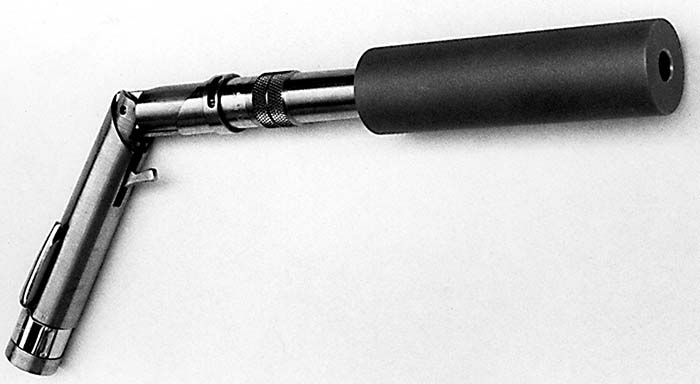
Performance
The diminutive LDES-2 was tested using Federal high velocity, Hansen standard velocity target, and Baikal Junior Brass subsonic LR ammunition in the Walther TPH, the Beretta 21A, and the Braverman Pen Gun. The mean (average) sound signatures appear in Table 3 and net sound reductions appear in Table 4. These tables also provide comparative data previously gathered on the JR Customs LDES, the redesigned Gemtech LDES, the Warp 3 from AWC Systems Technology, and the new Backdraft suppressor from AWC Systems Technology. Related projectile velocities appear in Table 5.
The first thing to notice is that the Walther TPH and Beretta 21A provide identical sound signatures with all kinds of ammunition when no suppressor is attached to the barrel. But the Walther provides significantly more bullet velocity than the Beretta with all kinds of ammunition. It’s too bad the Walther’s light primer hits generate such frequent misfires. Curiously, the Braverman Pen Gun provides less velocity than the Beretta with high velocity and standard velocity fodder, but more velocity with Russian subsonic ammunition.
Whether mounted on the Walther or Beretta, the Gemtech LDES-2 produces a sound signature of 130 dB or less regardless of ammunition, which is good enough for most tactical or recreational requirements in the real world. These sound pressure levels are comparable to many good submachine gun suppressors when used with subsonic ammunition. The LDES-2 provides net sound reductions that run 27-30 decibels regardless of the pocket pistol or ammunition being used. The slightly larger Gemtech LDES provides a superb 35-40 dB of sound reduction, while the Backdraft from AWC Systems Technology provides 33-34 dB net sound reduction.
The little LDES-2 worked surprisingly well on the Braverman Pen Pistol, dramatically taming both the sound signature and the sting of the pistol’s recoil. With high velocity ammunition, the silenced pen pistol has a sound signature of 127 decibels, which is the same sound pressure level as a factory-original H&K MP5 SD integrally silenced submachine gun. When the LDES-2 is used with standard velocity and subsonic fodder, the respective sound signatures of 120 and 122 decibels are noticeably quieter than some mainstream integrally suppressed .22 rifles.
The LDES-2 was also mounted on a Beretta 950 BS Minx pistol and tested with high velocity and standard velocity .22 Shorts. Table 6 provides the mean sound signatures, Table 7 provides net sound reductions, and Table 8 provides related velocity data. These tables also contain comparative data on Ciener’s SBER dry can for the Minx as well as the Cobray mesh-filled BP22 suppressor.
Regardless of ammunition type used in the Minx pocket pistol, the LDES-2 suppressor produced a sound signature of 126 decibels, which is in the same ballpark as the Long Rifle fodder produced when this can was fitted to the Walther TPH and Beretta 21A pistols. It should not be surprising that the net sound reductions produced by this wet can were much better than the performance of the dry SBER suppressor.
Several interesting aspects of the velocity data merit discussion. Projectile velocities are greater when the LDES-2 is fitted to the Gemtech suppressor than when the same pistol is fired without a suppressor. This phenomenon, which is called freebore boost, occurs because the expanding combustion gases continue to push against the rear of the bullet as it passes through the primary expansion chamber of the suppressor. The Minx with Gemtech barrel and LDES-2 muzzle can provided significantly more bullet velocity than the Minx with Cobray suppressor, since the wipes in the Cobray can considerably slowed the projectiles. Finally, it is interesting that the ported extra-length barrel of Ciener’s SBER integral suppressor still managed to produce more projectile velocity than the unported Gemtech barrel.
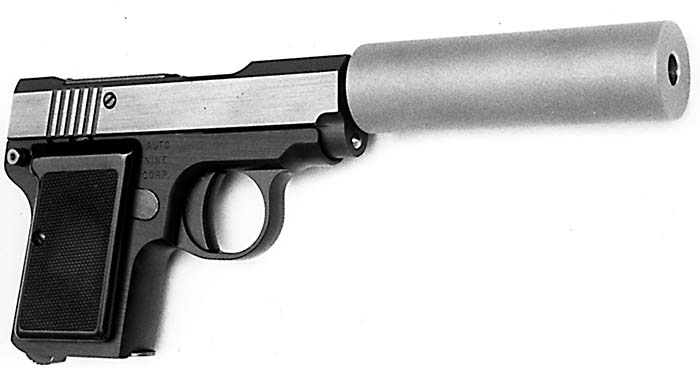
Tables 9 and 10 show the raw sound data when three magazines-worth of ammunition were fired through the LDES-2 mounted on the Walther TPH and Beretta 21A pistols, respectively, without recharging the suppressor with coolant between magazine changes. It is imperative, however, that the operator tighten the suppressor on the barrel between magazine changes. This behavior every time the magazine is changed should become instinctual with any screw-on suppressor, much like visually checking a chamber to confirm that a firearm is truly unloaded. While unsuppressed sound signatures vary by a few tenths of a decibel from shot to shot, these data provide a representative look at the intrinsic data variability common to suppressor testing. These data also show surprisingly little change after so many shots have been fired through a tiny wet suppressor without replenishment of the coolant medium.
Table 11 summarizes suppressor performance of the LDES-2 on Walther TPH and Beretta 21A pistols. Clearly, recharging coolant every three magazines provides performance within a decibel or two of recharging the suppressor every time the magazine is changed. The exceptional ability to retain a coolant medium throughout prolonged usage is a characteristic of the LDES family of suppressors.
The LDES-2 suppressor can also be used without coolant, providing good performance on .22 rifles but significantly less impressive performance on pistols.
Using a Wet Can Without Coolant
There are several reasons for shooting the LDES-2 and other ultra-compact suppressors without coolant media: (1) the process provides valuable insight into the intrinsic behavior of a given baffle design; and (2) the process is a lot less messy. Table 3 provides the sound signatures produced by the LDES-2 and other small wet suppressors when fired without coolant using .22 LR ammunition. Table 4 provides the net sound reductions. Tables 6 and 7 provide this information when the dry can is fired using .22 Shorts.
When employed dry, the LDES-2 provides a net sound reduction of 13 decibels with all kinds of .22 LR fodder. This performance increases to 17 dB with high velocity Shorts and 20 dB using standard velocity Shorts. Remarkably, that’s within a decibel or two of the performance delivered by the much larger Ciener SBER suppressor.
Thus when employed dry, the LDES-2 lowers the sound signature of a Beretta Minx to well below the European hearing risk limit of 140 dB, so hearing protection will not be required to safeguard operator hearing when firing .22 Shorts in a pocket pistol. When used dry with the Long Rifle cartridge on a pocket pistol or pen gun, however, the sound signature will exceed the European risk limit and hearing protection should be used when the can is employed without coolant.
Tables for LDES-2


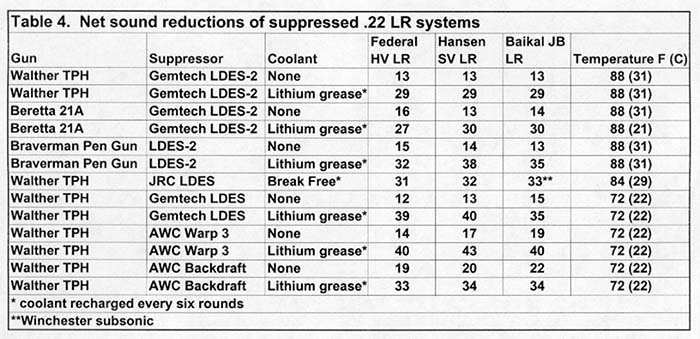


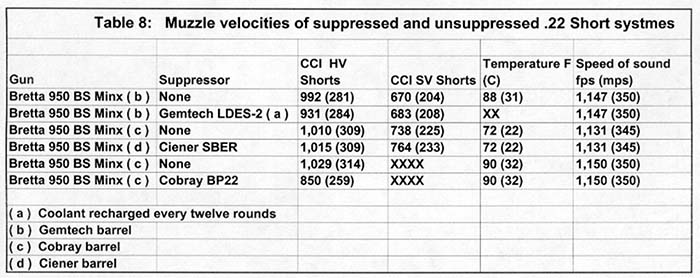
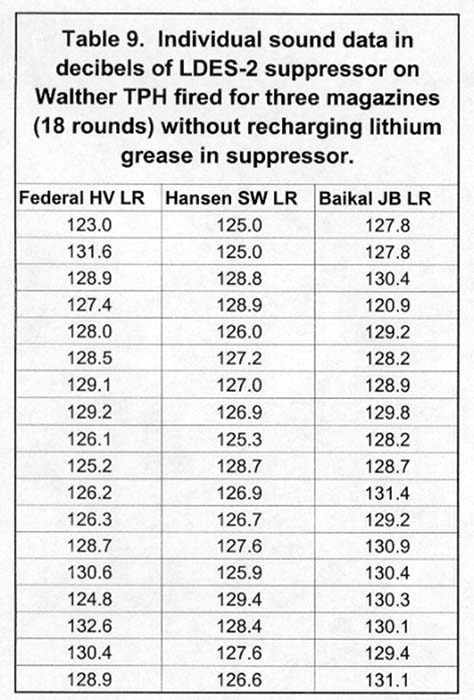

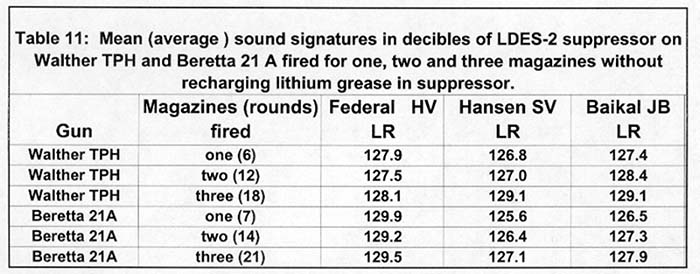
Conclusions
Gemtech’s LDES-2 is not only the smallest practical suppressor I’ve ever seen, it provides plenty of sound suppression for most operational requirements. Ideally suited for pocket pistols and pen guns, the 7/8 inch (22 mm) diameter of the tiny muzzle can allows the full use of sights on a Walther TPH pistol. Furthermore, the LDES-2 dramatically tames the blast and recoil of a pen gun, and the little suppressor can be concealed with unprecedented ease. While the larger LDES from Gemtech and the Backdraft from AWC Systems Technology provide superior sound reduction for the most demanding applications, the LDES-2 still provides comparable sound pressure levels to quality submachine gun suppressors using subsonic ammunition. This mighty mite from Gemtech packs very good performance into the smallest possible package. Jim Ryan really did his homework on this outstanding design.
| This article first appeared in Small Arms Review V1N2 (November 1997) |











